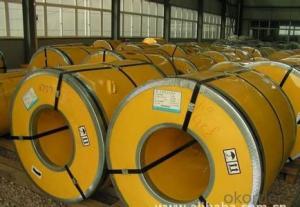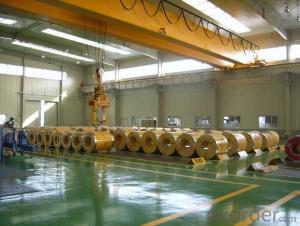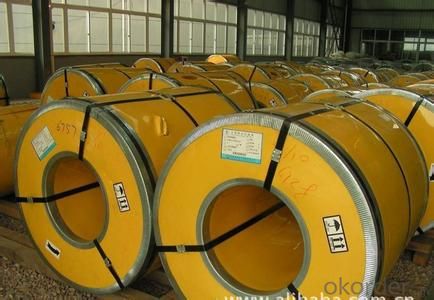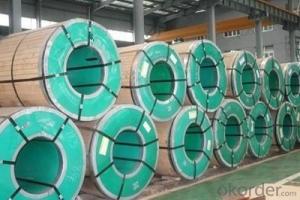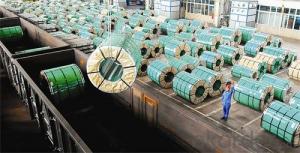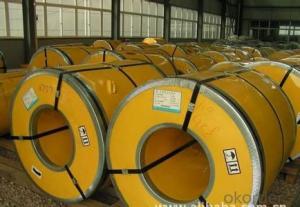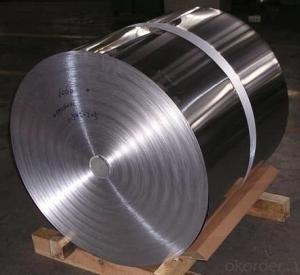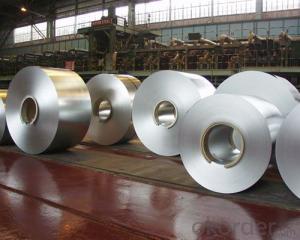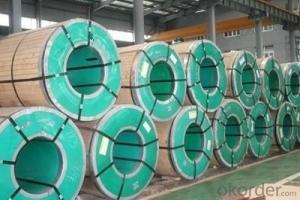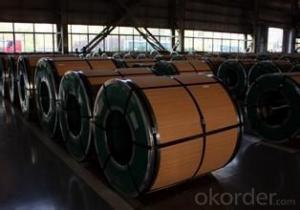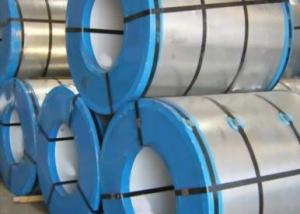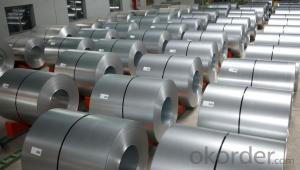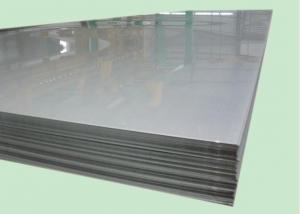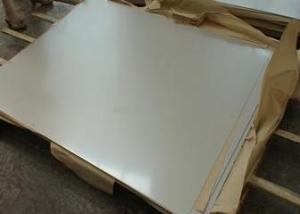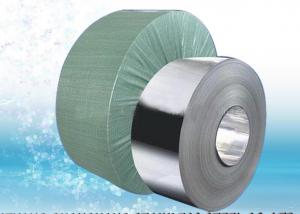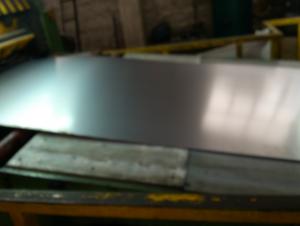Stainless Steel Coil Cold Rolled 201 Full Hard Surface No.2E with High Quality
- Loading Port:
- China main port
- Payment Terms:
- TT or LC
- Min Order Qty:
- 25 m.t.
- Supply Capability:
- 20000 m.t./month
OKorder Service Pledge
OKorder Financial Service
You Might Also Like
1. Structure of Stainless Steel Coil Cold Rolled 201 Descriptions
Stainless Steel 201 is a new kind of Austenite stainless steel by used Mn, N replace Ni.
The steel has good corrosion resistance and hot / cold processing performance, instead of 304 stainless steel products for used in the not high of corrosive environment, such as indoor, inland city outdoor etc.
2. Main Features of the Stainless Steel Coil Cold Rolled 201
Thickness: 0.2mm to 1.5mm
Width: 10mm to 1240mm
Type: 200 Series
Length: As customer's requested
Standard: JIS, SUS, AISI, ASTM
Grade: 201-J1, 201-J4, AISI201, AISI202…
Finish: BA, 2B, 8K, NO.3, NO.4, HL…
Hardness: Low Hard(190 HV Max); Half Hard(240-280HV); Full Hard(42-60 HRC)
Delivery Time: 15 to 20 day after the receive the deposit or 100%LC
Packaging: By wooden pallet, wooden case or according to customer's request
3. Stainless Steel Coil Cold Rolled 201 Images
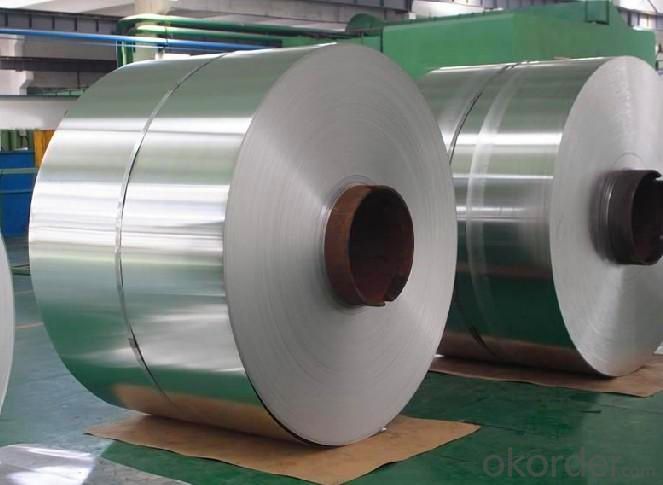
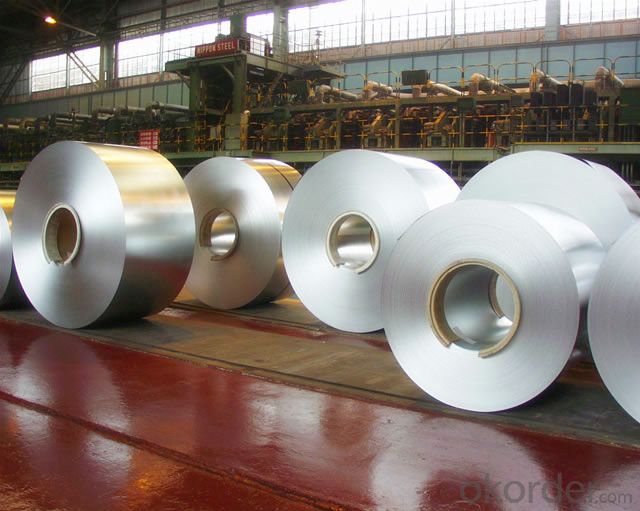
4. Stainless Steel Coil Cold Rolled 201 Specifications
Mechanical Property Contrast | YS (Mpa) | TS (Mpa) | EL(%) | HV | REMARK |
Stainless Steel 201 | 426 | 880 | 52 | 224 | 1.0t |
Stainless Steel 304 | 285 | 710 | 58 | 165 | 1.0t |
Stainless Steel 200 Series Chemicals Contrast (wt. %) | ||||||||
Chemicals | C | Si | Mn | Cr | Ni | N | Other | |
205 | 0.12-0.25 | ≤0.75 | 14.0-15.0 | 16.5-18.0 | 1.0-1.75 | 0.32-0.4 | ||
JIS, | 201 | ≤0.15 | ≤1.0 | 5.5-7.5 | 16.0-18.0 | 3.5-5.5 | ≤0.25 | - |
201L | ≤0.03 | ≤0.75 | 5.5-7.5 | 16.0-18.0 | 3.5-5.5 | ≤0.25 | - | |
202 | ≤0.15 | ≤1.0 | 7.5-10.0 | 17.0-19.0 | 4.0-6.0 | ≤0.25 | - | |
201LN | ≤0.03 | ≤0.75 | 6.4-7.5 | 16.0-17.5 | 4.0-5.5 | 0.1-0.25 | Cu≤1.0 | |
India | 201-J1 | ≤0.08 | ≤0.75 | 7.0-8.0 | 15.0-17.0 | 4.0-5.0 | ≤0.1 | Cu≤1.5 |
201-J3 | ≤0.08 | ≤0.75 | 9.0-10.5 | 14.0-16.0 | 2.0-3.0 | ≤0.15 | Cu≤2.0 | |
201-J4 | ≤0.10 | ≤0.75 | 8.5-10.0 | 15.0-16.0 | ≤1.2 | ≤0.2 | Cu≤2.0 | |
America | 204 | ≤0.03 | ≤1.0 | 7.0-9.0 | 15.0-17.0 | 1.5-3.0 | 0.15-0.3 | (Cu) |
H400 | ≤0.10 | ≤1.0 | 6.0-9.0 | 17.0-19.5 | ≤3.5 | ≤0.3 | - | |
Japan | YUS130S | 0.09 | 0.5 | 11.0 | 18.0 | 6.5 | 0.35 | - |
NTK S-4 | 0.17 | 0.43 | 14.7 | 17.7 | 1.3 | 0.35 | - | |
NM15M | 0.08 | 0.8 | 14.5 | 17.0 | 4.3 | 0.33 | - | |
Europe America | 219 | ≤0.04 | ≤0.75 | 8.0-10.0 | 19.0-21.5 | 5.5-7.5 | 0.15-0.4 | - |
Cromanite | ≤0.08 | ≤1.0 | 9.5-11.0 | 18.0-20.0 | ≤1.0 | 0.4-0.6 | - | |
201 Surface | Characteristic and Application of Stainless Steel Coil Cold Rolled 201 |
2B | The surface brightness and flatness of 2B is better than 2D then through a special surface treatment to improve its mechanical properties, 2B could nearly Satisfy comprehensive uses |
No.4 | Polished with abrasive belt of grit#150#180, have better brightness with discontinuous coarse stria, but thinner than NO.3, are used as bathtub buildings inner and electrical appliances kitchen utensils and food processing. |
BA | Cold rolled, bright annealed and skin-passed, the product have excellent brightness like mirror kitchen apparatus, etc. |
8K | The product have excellent brightness and prefer bright can be the mirror. |
5. FAQ of Stainless Steel Coil Cold Rolled 201
Q: Are you factory or trader?
A: We certainly are stainless steel manufacturer and have processing plant.
Q: Can you provide mill test certificate?
A: Yes! Mill test certificate for both hot rolled raw material coils and cold rolled coils are available.
Q: How to get a sample?
A: Free samples are available for your checking and testing. And to get free samples, please send us your detailed receiving address (including post code) and your DHL/FEDEX/UPS account for collecting samples, courier cost will be paid in your side.
- Q: What are the different types of edges available for stainless steel strips?
- The desired appearance and specific application determine the available types of edges for stainless steel strips. Examples of common edge types include: 1. Mill Edge: This straight and smooth finish is the standard produced during manufacturing, with no further processing or treatment. 2. Slit Edge: Achieved by cutting the strip to the desired width using a slitting machine, this edge may have a slight burr or roughness that can be eliminated through deburring or other finishing methods. 3. Rounded Edge: Also called a round or rolled edge, it involves rolling the strip to create a curved or rounded profile. This type of edge provides a safer and more comfortable surface, suitable for applications where sharp edges may be hazardous. 4. Deburred Edge: By removing burrs or roughness from the strip's edge, a smooth and clean finish is achieved. Deburring is typically done using specialized equipment or processes. 5. Beveled Edge: This edge is created by cutting the strip at an angle, usually 45 degrees, resulting in a sloping or chamfered edge. Beveled edges are often used for aesthetic purposes or to facilitate welding or joining of the strips. 6. Custom Edges: Custom edges can also be created to meet specific functional or aesthetic requirements of a project or application. These may include different profiles, finishes, or treatments. When selecting the appropriate edge type, it is crucial to consider the intended use and requirements of the stainless steel strips. The edge choice can impact the final product's performance, appearance, and safety.
- Q: How do you prevent intergranular corrosion of stainless steel strips?
- To avoid intergranular corrosion of stainless steel strips, several steps can be taken: 1. Opt for low carbon grades: Intergranular corrosion occurs when chromium carbides precipitate at grain boundaries due to prolonged exposure to high temperatures. By using low carbon grades like Type 304L or Type 316L, the carbon content is minimized, reducing carbide formation and preventing intergranular corrosion. 2. Employ heat treatment: After welding or other high-temperature processes, it is essential to properly heat treat stainless steel strips to restore their corrosion resistance. This process, known as solution annealing or sensitization treatment, involves heating the material to a specific temperature range and rapidly cooling it to dissolve carbides and prevent their precipitation at grain boundaries. 3. Utilize pickling and passivation: Pickling involves the use of acid solution to eliminate impurities or contaminants from the surface of stainless steel, while passivation creates a protective oxide layer that enhances corrosion resistance. Regular pickling and passivation treatments can help prevent intergranular corrosion by eliminating potential corrosion sites and improving overall surface condition. 4. Avoid exposing stainless steel strips to high temperatures: Prolonged exposure to high temperatures can lead to sensitization and subsequent intergranular corrosion. If unavoidable, thermal barriers such as insulation or coatings can be used to minimize direct contact between stainless steel and elevated temperatures. 5. Employ corrosion inhibitors: Applying corrosion inhibitors, such as specialized coatings or inhibitors in the working environment, can provide an additional layer of protection against intergranular corrosion. These inhibitors work by forming a protective film on the surface of stainless steel, preventing the attack of corrosive agents and reducing the risk of intergranular corrosion. Overall, preventing intergranular corrosion of stainless steel strips involves a combination of material selection, appropriate heat treatment, surface treatment, and protective measures. By implementing these preventive measures, the risk of intergranular corrosion can be significantly reduced, ensuring the long-term durability and performance of stainless steel strips.
- Q: Can stainless steel strips be used in water treatment applications?
- Yes, stainless steel strips can be used in water treatment applications. Stainless steel is highly resistant to corrosion and can withstand exposure to water, making it an ideal material for use in water treatment processes where the strips may come into contact with water or other liquids. Additionally, stainless steel has hygienic properties, is easy to clean, and has excellent longevity and durability, making it a suitable choice for water treatment applications.
- Q: Can stainless steel strips be used in medical implants?
- Medical implants can utilize stainless steel strips, which are commonly used in the medical industry due to their exceptional corrosion resistance, durability, and biocompatibility. They are frequently employed in the production of medical devices such as surgical instruments and orthopedic implants. To meet the specific requirements of different medical implants, stainless steel strips can be shaped and sized accordingly. The material's ability to resist corrosion ensures its ability to withstand bodily fluids and harsh internal environments, consequently reducing the risk of implant failure or infection. Furthermore, extensive research and documentation have confirmed the biocompatibility of stainless steel. This means that it is well-tolerated by the human body and does not cause any adverse reactions. Thus, stainless steel is a secure and dependable option for medical implants, minimizing the chances of allergic reactions or long-term complications. Nevertheless, it is important to acknowledge that the choice of materials for medical implants ultimately relies on the particular application and the unique needs of each patient. Consulting with medical professionals and adhering to regulatory guidelines is vital in determining the most appropriate material for each individual case.
- Q: Can stainless steel strips be used in the wastewater treatment industry?
- Yes, stainless steel strips can be used in the wastewater treatment industry. Stainless steel is a material known for its corrosion resistance, durability, and strength, making it ideal for various applications in wastewater treatment plants. Stainless steel strips can be used in the construction of tanks, pipelines, and other equipment that come into contact with wastewater. In wastewater treatment plants, stainless steel strips are commonly used in the fabrication of screens, filters, and sieves. These components are crucial for removing solid particles, debris, and other impurities from the wastewater. Stainless steel strips are resistant to corrosion caused by the harsh chemicals and contaminants present in the wastewater, ensuring the longevity and effective performance of these components. Additionally, stainless steel strips are also used in the construction of pumps, valves, and fittings in wastewater treatment plants. These components need to withstand high pressure, aggressive chemicals, and continuous exposure to wastewater. Stainless steel's excellent mechanical properties, including high tensile strength and resistance to erosion, make it a suitable choice for such applications. Furthermore, stainless steel is also hygienic and easy to clean, which is essential in the wastewater treatment industry to prevent the growth and accumulation of bacteria and other harmful microorganisms. Stainless steel strips can be easily maintained, reducing the risk of contamination and ensuring the efficiency of the treatment process. Overall, stainless steel strips are a reliable and durable material for use in the wastewater treatment industry. They offer excellent corrosion resistance, strength, and hygienic properties, making them suitable for various applications in wastewater treatment plants.
- Q: How do stainless steel strips resist pitting?
- Stainless steel strips resist pitting due to the presence of chromium in the alloy, which forms a passive oxide layer on the surface. This oxide layer acts as a protective barrier, preventing the penetration of corrosive agents and thus reducing the risk of pitting corrosion.
- Q: Can stainless steel strips be used in automotive body panels?
- Indeed, automotive body panels can utilize stainless steel strips. With its versatility and durability, stainless steel proves to be an exceptional material that offers remarkable resistance against corrosion, substantial strength, and an elegant appearance. Due to these properties, stainless steel is suitable for various automotive applications, including body panels. These strips can be manipulated, welded, and molded into diverse panel designs, granting flexibility and customization options in terms of design. Moreover, stainless steel's ability to withstand rust and oxidation renders it ideal for enduring harsh outdoor conditions and exposure to road salt, which are prevalent in automotive environments. In summary, stainless steel strips present a dependable and long-lasting solution for automotive body panels.
- Q: Are stainless steel strips suitable for high-temperature exhaust systems?
- Yes, stainless steel strips are suitable for high-temperature exhaust systems. Stainless steel is known for its excellent heat resistance and durability, making it an ideal material choice for exhaust systems that operate at high temperatures. It can withstand the intense heat generated by the exhaust gases without warping or corroding, ensuring long-lasting performance and reliability.
- Q: How do stainless steel strips resist erosion?
- Stainless steel strips have the ability to resist erosion due to their unique composition and properties. Firstly, stainless steel is an alloy that contains a high percentage of chromium, which forms a protective layer of chromium oxide on the surface of the steel. This layer acts as a barrier, preventing oxygen and moisture from reaching the underlying metal and thus protecting it from corrosion and erosion. Additionally, stainless steel strips are also highly resistant to acids, alkalis, and various chemicals, which makes them suitable for applications in harsh environments. The presence of other alloying elements such as nickel and molybdenum further enhances the corrosion resistance of stainless steel. Furthermore, the structure of stainless steel, particularly the austenitic stainless steel, provides excellent strength and toughness, making it more resistant to mechanical erosion. The combination of its corrosion resistance and mechanical properties makes stainless steel strips highly durable and able to withstand erosive forces. Moreover, stainless steel strips can be treated with various surface finishes like passivation or electro-polishing, which further improves their resistance to erosion. These treatments remove impurities and contaminants from the surface, creating a smoother and more corrosion-resistant finish. Overall, the ability of stainless steel strips to resist erosion can be attributed to their corrosion-resistant composition, surface treatments, and excellent mechanical properties. These factors make stainless steel an ideal material for various applications where erosion resistance is crucial, such as in the manufacturing of automotive components, kitchen appliances, and chemical processing equipment.
- Q: Can stainless steel strips be used in water heaters?
- Yes, stainless steel strips can be used in water heaters. Stainless steel is a corrosion-resistant material that can withstand high temperatures and is commonly used in water heater components, including heating elements, tanks, and pipes, due to its durability and resistance to rust and scaling.
Send your message to us
Stainless Steel Coil Cold Rolled 201 Full Hard Surface No.2E with High Quality
- Loading Port:
- China main port
- Payment Terms:
- TT or LC
- Min Order Qty:
- 25 m.t.
- Supply Capability:
- 20000 m.t./month
OKorder Service Pledge
OKorder Financial Service
Similar products
Hot products
Hot Searches
Related keywords
